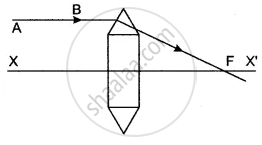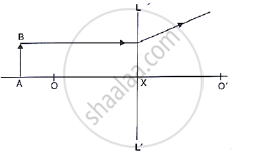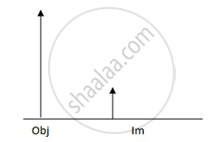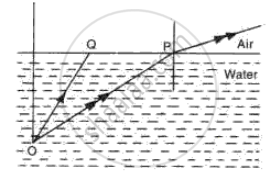Advertisements
Advertisements
प्रश्न
The diagram showed a lens as a combination of one glass block and two prisms. Complete the ray diagram and show the part of the incident ray AB after passing through the lens.
(i) Name of the lens formed by the combination.
(ii) What is the line XX’ called?
(iii) Mark the focus F.

उत्तर
The completed ray diagram is shown.

(i) The lens formed by the combination is the convex lens.
(ii) The line XX’ is called the principal axis.
(iii) The focus has been marked by the letter F in the diagram.
APPEARS IN
संबंधित प्रश्न
Distinguish between a real and a virtual image.
Study the diagram shown in Fig. 5.56
Where is the image formed?

The diagram given below shows the position of an object OA in relation to a converging lens whose foci are at F1 and F2.

Describe three characteristic of the image.
In the following diagram , the object and the image formed by the respective lenses are shown. Complete the ray diagram, and locate the focus. Find the focal length of the lens.

Make the rrect choices in the following items :
An object is placed 50 cm from a connverging lens of focal length 30 cm. The image produced would be
Fig. shows two rays of light Op and OQ coming from an object at the bottom of a pond, incident on the water surface.

(a) Mark on the diagram
(i) The angle of incidence of ray OP,
(ii) The angle of refraction of ray Op,
(iii) The position of image of the object as seen from above.
(iv) An approximate path of the ray OQ.
(b) Explain, why do the rays of light change directions on passing from water to air.
(c) A fish in water sees everything outside the water by rays of light entering its eye in a small cone of light. Draw a diagram and explain how does this happen.
Complete the following diagram and state what happens to the ray of light after refraction through the lens.

Draw a ray diagram to show the image formed by a convex lens when the object is placed between F and 2F.
